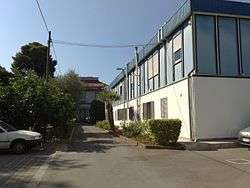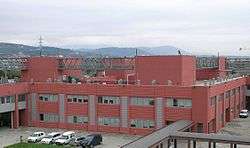Istituto di Genetica Vegetale

Istituto di Genetica Vegetale (IGV) is an integral part of the institutes of the Italian Consiglio Nazionale delle Ricerche (National Research Council). It is officially located in Bari and has four different Divisions, located in Portici, Palermo, Florence and Perugia. IGV started its activities on November 2002. In the framework of the new CNR National Research Network, IGV is the result of the fusion of five former Institutes, operating in the field of Plant Genetics and Breeding, namely Germplasm Institute – Bari; the Institute of Forest Tree Breeding - Florence, Research Institute of Ornamental and Vegetable Plant Breeding -Portici, Research Institute for Citrus Genetics, Palermo; Research Institute for Grass and Fodder Crop Breeding - Perugia.
Research Lines
A particular attention is being paid to specific sectors of the plant genetic resources such as local agro-ecotypes, ecotypes threatened of extinction, wild relatives of the cultivated plants, wild species used by man for several purposes, species that can be potentially exploited for the extraction of bio-active or technological products, and finally the model species. Currently the Section of Bari preserves around 80.000 samples belonging to more than 40 genera and about 600 species. Numerous accessions have been acquired through the exchange with other Institutions. Altogether from 1972 over 80.000 samples have been distributed all over the world.
Small data banks also exist on specific aspects, such as the protein quality and antinutritional factors (in wheat, bean, faba bean, lentil, cowpea), resistance to biotic stress (in wheat and faba bean), plant characters (in wheat and chickpea), rare, very rare and endemic angiosperm Italian species.
From a general point of view the results and acquired experience have allowed the Section in Bari to become a reference of excellence in the national and international scientific community in the field of the safeguard of plant biodiversity. This has favoured the start of operational contacts with several public and private subjects interested in the exploitation of plant genetic resources.
Wheat lines have been detected which contain a high level of proteins and lines characterized by protein components associated to pasta-making quality.
Seed Bank
The Section of Bari possesses cold rooms for the maintenance of seeds: for long storage seeds are kept at -20 °C; for short-medium term conservation, 0 °C and 30% of relative humidity are used.
The Section of Bari has developed collaborations with analogous national (Faculty of Agriculture, Institutes of the CNR, MiPAF, ENEA, etc.) and international (FAO, IPGRI, IITA, ICARDA, IPK, etc.) Institutions.
Bioinformatics
In the last years has begun the development of a bioinformatics activity which has seen the creation of the web Data base of the accessions from the seed bank and of some of the results of the research activity. Those data bases are accessible on line in the official website.[1]
Divisions
Research division of FIRENZE

The main research activities are concerned on the following topics. Analysis of the genetic structure and the variability within and between populations of forest tree species. The Institute can be now considered one of the leader at National and International level as it has been one of the first to set up and use the new biotechnologies to develop a lot of different biochemical and DNAmarkers. The Institute has given a fundamental and sometimes original contribution to the increase of the knowledge in forest topics:
- defining the level and the distribution of the genetic resources;
- exploring the phylogenetic relationships between different species;
- studying mechanisms involved in the maintenance of the genetic variability and potential adaptability.
Research division of PALERMO
The research activity range over all the fields of Citrus genetics. Main topics are:
- Scion and rootstock improvement by conventional (hybridation and clonal selection)and biotechnological (protoplast colture, tissue colture, somatic embryogenesis) methods;
- Selection of useful genotypes;
- Molecular analysis and characterization of regenerated plants;
- Tissue culture for sanitation;
- Gene identification and isolation;
- Genetic transformation;
- Studies on the pharmacological and alimentary properties;
- Preservation and enhancement of local germplasm;
- Evaluation of plants suitable for ornamental use.
The main goal of our research program is to obtain and select superior scion varieties, as compared to the ones currently used and improved rootstocks that will provide growers with alternative choices for any location. The strategy is to enhance the genetic variability in order to select new individuals.
Research division of PERUGIA
In the last 5–8 years the scientific activity of the division was up dated again with the arrival of new researchers, with new investigated species typical of the Umbria region where the division is operating and with new and more current research lines. The research on tree species such as Olive (Olea europaea) and Cherry (Prunus avium) was started in close collaboration with the regional public institutions focusing on two main objectives:
- production of fingerprints of Italian varieties and
- development of a database of molecular markers used in the perspective to study the association between candidate genes and/or anonymous molecular markers and traits of agronomic interest.
In the last years a research line on truflle received a strong development, considering that Umbria is one of the very few regions that can boast appreciable productions of all the most important and prestigious species.
Research division of PORTICI

Since the beginning, the research activities have been aimed at the genetic improvement of several vegetable crops by conventional and biotechnological approaches. Most of the research projects are focused on ornamental and vegetable crops of economic interest for Southern Italian agricultural areas, such as tomato, potato, artichoke, tobacco. The main research objectives are designed at the developing and maintaining the genetic variability, speeding up the selection of superior genotypes, understanding the genetic control of reproduction and its association with yield improvement, increasing quality and tolerance to biotic and abiotic stress, through bio-molecular techniques, chromosomal manipulation and cell and tissue culture. In particular, the current research activities are focused on:
- Identification, characterization and genetic transfer of genes involved in the adaptation and tolerance to environmental stress conditions (heat, cold, drought and salt) in potato and tomato and the model species Arabidopsis;
- Development and use of molecular markers for varietal identification and assisted selection;
- Genetic control and manipulation of sexual reproduction, by studying mutants and identifying key genes;
- Innovative genetic-molecular approaches to improve and exploit local tomato varieties;
- Introgression of useful genes (genes for biotic and abiotic constraints, genes for quality) from wild potato species into potato, rose, tomato, by somatic hybridization and interspecific crossing schemes;
- Valorization of genetic resources of vegetable, ornamental and medicinal plants, typical of Southern Italian and Mediterrean areas;
- Development of an efficient technology of plastid transformation and expression of useful genes for products destinated to agro- and pharmaceutical industries.
References
External links
- Official website
- www.cnr.it, homepage of the CNR website. (English)